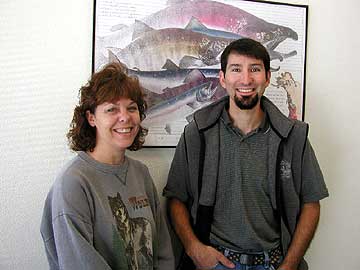Recent Events and New Employees
by Doug Schleusner, Executive Director,
Trinity River Restoration Program
| Water Year |
Water Volume Released (acre-feet) |
| 2004 |
683,300 |
| 2003 |
486,000 |
| 2002 |
469,000 |
| 2001 |
369,000 |
| 2000 |
340,000 |
No, it’s not your imagination. More water has been flowing down the Trinity River. In fact, each of the past five years has seen a progressively larger volume of water released (see following table). Water year 2002 was a “normal water year” and both 2003 and 2004 were classified as “wet water years.” Although it is way too soon to make any predictions about 2005, the recent series of storms is certainly reason for optimism.
The July 2004 opinion by a three-judge panel of the 9th Circuit Court of Appeals sets the stage for higher peak releases called for in the December 2000 Record of Decision. Previously limited by physical structures to releases of 6,000 cubic feet per second (cfs), the necessary bridge modifications featured in the last newsletter are still on track, and other floodplain structure modifications are in the planning stages. The Trinity River Restoration Program (TRRP) and its partners are doing everything possible to ensure that if 2005 is a wet water year, the associated higher releases of 8,500 cfs can be carried out safely and effectively to the benefit of the river and its fisheries.
 |
|
The two newest TRRP employees will help us meet this challenging work schedule. Denise Wiltse (left), formerly of Reclamation’s Shasta Dam office, and Joe Riess, most recently with the Redding office of CH2MHill, are both civil engineers in the Implementation Branch. |
Denise Wiltse has been involved with the Program since the mid-1990s, when she worked for both Reclamation and the State Department of Water Resources as a student engineer, where she gained experience in water quality monitoring and civil surveying. She received her engineering degree from Chico State University in 1999, was hired full-time by Reclamation, and then became involved in preliminary designs of the four Trinity River bridges that are now under construction. She will have primary responsibilities for floodplain structure modifications, and has already made extensive landowner contacts. Denise and her husband Vernon look forward to moving to Weaverville from Redding in the near future.
Joe Riess has an undergraduate degree in environmental resources engineering from Humboldt State University, a graduate degree in civil and environmental engineering from UC Davis, and is a registered professional civil engineer in California. He comes to the TRRP from the Redding office of CH2MHill, where he was the lead process engineer on a $54 million wastewater treatment plant expansion project near Lake Tahoe. This experience in civil engineering design and construction make’s Joe a valuable addition to our Implementation Branch, where he will have specific responsibilities for the Program’s channel rehabilitation projects. An avid kayaker and outdoor enthusiast, Joe enjoys spending time with his wife Tiffany on the local rivers and creeks, hiking with their three dogs, mountain biking, and skiing.
Even more recently, Dr. Rod Wittler has been temporarily reassigned from Reclamation’s Denver Technical Service Center to the TRRP Office as Acting Modeling and Analysis Branch Chief. Rod’s experience with the Program dates back to the mid-1990s when he became involved with the Flow Evaluation Study, eventually as one of the co-authors of the Report (more about him and several other new employees in another issue).
The science part of the program has received a boost in several other important areas. The Scientific Advisory Board is now fully staffed with five highly experienced individuals: Dr. Clair Stalnaker (retired U.S. Geological Survey senior scientist and co-author of the Trinity River Flow Study); Dr. Mike Merigliano (riparian ecologist with the University of Montana); Dr. Mike Sale (environmental systems group leader with the Oak Ridge National Laboratory); Mr. Josh Korman (fisheries biologist with Ecometric Research Associates); and Dr. Ned Andrews (senior physical scientist with the U.S. Geological Survey). These scientists, along with about 50 other resource specialists and scientists affiliated with the Program, recently met in Eureka to develop and refine the conceptual resource models which will lead to a comprehensive monitoring and evaluation plan for the Restoration Program in the coming year.
|




